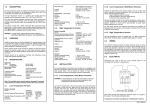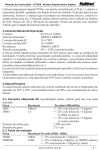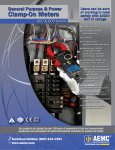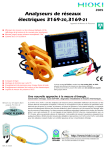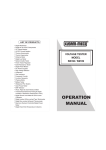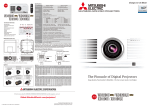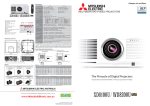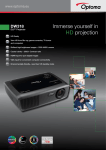Download Charge air cooler maintenance
Transcript
Charge air cooler maintenance considerations – what you must do. Today’s emphasis on fuel economy and exhaust emissions places a great deal of responsibility on regulators, engine builders and owners. Regulators dictate emission limits to engine manufacturers who then build compliant products for the market place. However, the legal responsibility for continued emissions compliance lies with the engine owner and maintenance of the Technical File and proof of adherence to recommended maintenance schedules should ensure that any emissions audit goes smoothly. Diligent record-keeping and the use of original-equipment rather than grey-market or will-fit parts can lead to the assumption that an engine will maintain advertised fuel consumption and emission limits throughout its useful life. This may be the case with normally-aspirated engines but they are increasingly rare in emissionscompliant marine propulsion and auxiliary applications. Turbocharging and charge-air cooling are now the norm as, together, they facilitate improved combustion air management for reduced exhaust emissions. The charge air cooler (often called an after-cooler or inter-cooler) permits a significant amount of heat to be removed from the combustion air after it leaves the turbocharger and before it enters the engine combustion chambers. This cooled air has two effects. Firstly, it can reduce combustion temperature so that the production of NOx is lowered. Secondly, it increases the combustion air density (more oxygen) so that more fuel can be burned efficiently in the finite space of the combustion chamber therefore allowing the engine to produce even more power. Engine manufacturers establish the power output of the engine based on its mechanical and thermal design, duty cycle and ability to comply with mandated emissions limits. In marine applications, charge air coolers use raw (sea or lake) water, jacket water or a separate circuit of fresh water as the cooling medium. Raw water is less popular because of its potentially corrosive and sediment-laden properties that can damage or impair the efficiency of the cooler. Jacket water, by nature of its relatively high temperature, limits the amount of heat that can be removed from the combustion air. More common is the use of a low-temperature, thermostatically controlled, separate fresh water circuit sometimes in stage-series with a jacket water cooled charge air cooler. Charge air cooler cores are similar to vehicle radiators and can be tube and fin or bar and plate design. They are densely constructed to resist high thermal and mechanical loads while having the ability to remove large amounts of heat from the combustion air after it passes through the very hot turbocharger. For example, a modern 4500bKW rated medium-speed engine requires a charge air cooler capable of removing approximately 2000kw of heat from the combustion air at full load. Encasement in a cast or fabricated metal housing makes superficial visual inspection of the core difficult. As a result the condition of the cooler core might be ignored until the engine exhibits a related performance problem such as elevated exhaust temperature, decreased performance, exhaust smoke and/or turbocharger surge. A charge air cooler passes an enormous mass of air on its way to the engine combustion chambers. In our 4500bKW rated engine example, this can be in the region of 27,000 cubic meters/hr. Suspended machinery space air contaminants, such as oil mist or solid particulates that are not trapped by an upstream filtration system can easily accumulate on the air side of the core and reduce its heat transfer efficiency while causing an air flow restriction. Engines equipped with closed crankcase fumes absorption systems usually have more stringent cooler core cleaning schedules as they tend to foul more quickly due to residual oil-mist passing through the fitted micronic air filter element. Poor coolant condition can also cause the very narrow channels inside the cooler tubes to become restricted or blocked entirely, also reducing its heat transfer capability. The core therefore requires monitoring and maintenance on the air and water sides. The charge air cooler core on this high-speed marine diesel is located under the black cast metal housing on the top of engine. The core is accessible by removing the top of the housing and disconnecting the air and cooling connections. The closedcrankcase ventilation system requires that the core is monitored intensively for efficiency and cleaned regularly to preserve engine performance and emissions compliance. This charge air cooler core, removed from a high-speed engine after approximately 4000hrs operation, is heavily fouled on the air side with oil residue from the closed crankcase ventilation system. Its heat transfer capability is reduced by approximately 60% resulting in higher engine fuel consumption, elevated exhaust temperatures and impaired performance. Removal and cleaning each 1000hrs of operation is now part of the owner’s maintenance schedule. The best way to evaluate the efficiency of the charge air cooler without removing it from the engine is to measure the air temperature and pressure differentials across the core with calibration- certified instrumentation. Measuring the differential temperature of the cooling water passing through the core will also help with secondary diagnostics. This practise is well understood by most professional marine engineers and service technicians using either sensors permanently installed on the engine or ones that can be attached temporarily. Readings are always taken with the engine as near fullload as possible. Many medium-speed engine builders install charge air cooler differential switches or analogue sensors that connect directly to the ship’s alarm and monitoring system to warn of need to service the core before engine performance and longevity are possibly compromised. Engine manufacturers publish specific data for acceptable pressure and temperature differential limits across the charge air cooler core and should be consulted for appropriate information. These limits might allow pressure differentials of between 150% and 300% of testbed (new condition) levels before inspection and cleaning are required. Operating engines with higher differential pressures can result in increased fuel consumption, higher than permitted exhaust temperatures and emissions and engine damage. The engine service manual will provide safe practise and required clearances for removing and handling the charge air cooler core. It is important that the engine room layout provides adequately for this. Although the core is designed to withstand high thermal and mechanical stress when in service, it is not designed for improper handling. Damage to fins and tubes can result in very costly repairs. Contaminated charge air cooler cores should be thoroughly inspected for obvious signs of mechanical damage or leakage before the cleaning process commences. Photographic records and a written report on superficial observations are recommended. For shipping they need to be secured to a pallet or other carriage device to avoid damage in transit. If heavily oil-fouled the core should be wrapped in heavy plastic or placed in a containment tray to prevent oil escape to the environment. The manufacturer of the host 8000kw engine for this charge air cooler core recommends servicing when the pressure differential on the air side reaches 150% of new. Heavy deposition of airborne dust resulted in a pressure differential of almost 500% of new before it was removed for cleaning. The engine was in operational distress with significant cost to the owner and the environment. This graphic shows a duplex charge air cooler core that must be fully disassembled for cleaning and pressure testing. Reduced air velocity between the individual cores allows rapid contaminant deposition that cannot be removed by superficial cleaning. New gaskets and seals must be used during reassembly. Charge air cooler cores must not, under any circumstances, be cleaned with a commercial pressure washer. At best, this will only clean the outer structure of the core and the extremely high pressure at the nozzle can cause fin and tube damage. Instead it should go to a competent cooler servicing facility where cleaning tanks, filters and appropriate chemical solutions are available to remove accumulated foulings from the air and water sides in an environmentally sound manner. If the core is of the duplex type where individual sections are bolted together they should be separated before cleaning. Air gaps between the cores are more prone to plugging than the core sections themselves because of reduced air velocity that allows contaminants to settle out. Some charge cooler cores should not be cleaned ultrasonically as this can destroy the bond between the tubes and end plates. Certain ultrasonic frequencies can create damaging resonances in the fins and tubes during the cleaning process. Consult the engine maintenance manual for the correct procedure and do not send the core out for cleaning unless the chosen service-provider has the required equipment and quality control procedures. The choice of cleaning fluids depends on the material in the fins and tubes. Highly caustic or acidic wash fluid can corrode copper alloys but might be acceptable for stainless-steel. All cleaning fluid residue must be removed with thorough rinsing before the core assembly undergoes a detailed physical inspection and possible repair. This is normally followed by pressure-testing to ensure it’s suitability for additional, reliable service. A competent service facility should provide and “before” and “after” service report for inclusion in the engine’s history file. New gaskets and seals must be used when reinstalling the core on the engine. In the past there has been a tendency to ignore charge air cooler maintenance, particularly in smaller engines not fitted with an effective, in-place, monitoring system. Cleaning has often been deferred until overhaul time or when the engine incurs obvious performance problems. With the emphasis on fuel economy, emissions compliance and the need for maximum reliability between scheduled overhauls this needs to change. Regular charge air cooler maintenance is a very wise investment for the business and the environment. The duplex charge air cooler on this new 4500bKW marine propulsion engine is designed to remove 2000kw of heat from the combustion air before enters the cylinders. Note the separate connections for the low temperature and high temperature core sections. A pressure differential switch is fitted to provide a signal to the ship alarm system that cleaning is required. For cleaning the entire charge air cooler core assembly is removed axially from the engine. The engine room layout must allow sufficient room for removal and proper handling. It must be designed such that bulkheads and support posts do not interfere with safe cooler core removal. Appropriate rigging combined with safe handling procedures facilitate core maintenance.




